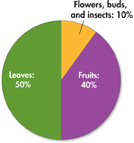Big Ideas in Biology
 What are the central themes of biology?
What are the central themes of biology?
The units of this book seem to cover different subjects. But we'll let you in on a secret: That's not how biology works. All biological sciences are tied together by themes and methods of study that cut across disciplines. These “big ideas” overlap and interlock, and crop up again and again throughout the book. You'll also notice that several of these big ideas overlap with the characteristics of life or the nature of science.
 The study of biology revolves around several interlocking big ideas: The cellular basis of life; information and heredity; matter and energy; growth, development, and reproduction; homeostasis; evolution; structure and function; unity and diversity of life; interdependence in nature; and science as a way of knowing.
The study of biology revolves around several interlocking big ideas: The cellular basis of life; information and heredity; matter and energy; growth, development, and reproduction; homeostasis; evolution; structure and function; unity and diversity of life; interdependence in nature; and science as a way of knowing.
Analyzing Data
What's in a Diet?
The circle graph shows the diet of the siamang gibbon, a type of ape found in the rainforests of Southeast Asia.

Interpret Graphs Which plant parts do siamangs rely on most as a source of their matter and energy?
Predict How would siamangs be affected if the rainforests they live in were cut down?
Analyze and Conclude
 Cellular Basis of Life Living things are made of cells. Many living things consist of only a single cell; they are called unicellular organisms. Plants and animals are multicellular. Cells in multicellular organisms display many different sizes, shapes, and functions. The human body contains 200 or more different cell types.
Cellular Basis of Life Living things are made of cells. Many living things consist of only a single cell; they are called unicellular organisms. Plants and animals are multicellular. Cells in multicellular organisms display many different sizes, shapes, and functions. The human body contains 200 or more different cell types.
 Information and Heredity Living things are based on a universal genetic code. The information coded in DNA forms an unbroken chain that stretches back roughly 3.5 billion years. Yet, the DNA inside your cells right now can influence your future—your risk of getting cancer, the amount of cholesterol in your blood, and the color of your children's hair.
Information and Heredity Living things are based on a universal genetic code. The information coded in DNA forms an unbroken chain that stretches back roughly 3.5 billion years. Yet, the DNA inside your cells right now can influence your future—your risk of getting cancer, the amount of cholesterol in your blood, and the color of your children's hair.
 Matter and Energy Living things obtain and use material and energy. Life requires matter that serves as nutrients to build body structures, and energy that fuels life's processes. Some organisms, such as plants, obtain energy from sunlight and take up nutrients from air, water, and soil. Other organisms, including most animals, eat plants or other animals to obtain both nutrients and energy. The need for matter and energy link all living things on Earth in a web of interdependent relationships.
Matter and Energy Living things obtain and use material and energy. Life requires matter that serves as nutrients to build body structures, and energy that fuels life's processes. Some organisms, such as plants, obtain energy from sunlight and take up nutrients from air, water, and soil. Other organisms, including most animals, eat plants or other animals to obtain both nutrients and energy. The need for matter and energy link all living things on Earth in a web of interdependent relationships.
 Growth, Development, and Reproduction All living things reproduce. Newly produced individuals are virtually always smaller than adults, so they grow and develop as they mature. During growth and development, generalized cells typically become more and more different and specialized for particular functions. Specialized cells build tissues, such as brains, muscles, and digestive organs, that serve various functions.
Growth, Development, and Reproduction All living things reproduce. Newly produced individuals are virtually always smaller than adults, so they grow and develop as they mature. During growth and development, generalized cells typically become more and more different and specialized for particular functions. Specialized cells build tissues, such as brains, muscles, and digestive organs, that serve various functions.
 Homeostasis Living things maintain a relatively stable internal environment, a process known as homeostasis. For most organisms, any breakdown of homeostasis may have serious or even fatal consequences.
Homeostasis Living things maintain a relatively stable internal environment, a process known as homeostasis. For most organisms, any breakdown of homeostasis may have serious or even fatal consequences.
 In Your Notebook Describe what happens at the cellular level as a baby grows and develops.
In Your Notebook Describe what happens at the cellular level as a baby grows and develops.
Table of Contents
- Formulas and Equations
- Applying Formulas and Equations
- Mean, Median, and Mode
- Estimation
- Using Measurements in Calculations
- Effects of Measurement Errors
- Accuracy
- Precision
- Comparing Accuracy and Precision
- Significant Figures
- Calculating With Significant Figures
- Scientific Notation
- Calculating With Scientific Notation
- Dimensional Analysis
- Applying Dimensional Analysis




